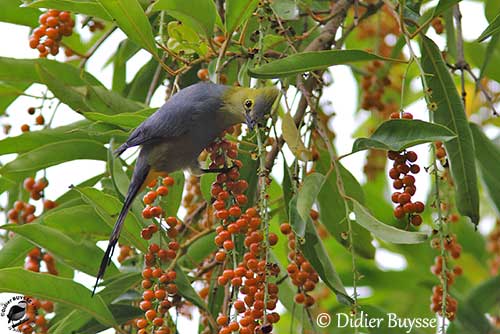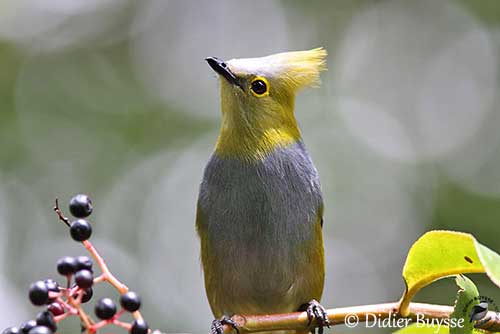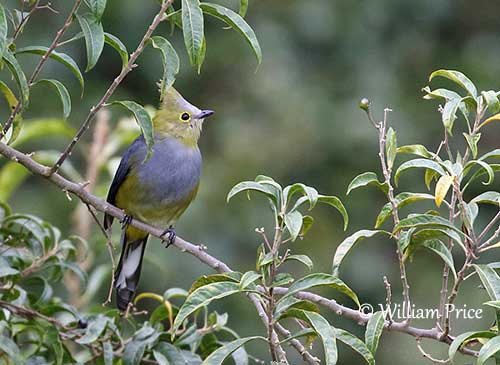
Fr: Ptilogon à longue queue
Ang: Long-tailed Silky-flycatcher
All: Langschwanz-Seidenschnäpper
Esp: Capulinero Colilargo
Ita: Pigliamosche di seta codalunga
Nd: Langstaartzijdevliegenvanger
Sd: långstjärtad silkesflugsnappare
Photographers:
Didier Buysse
Vision d’Oiseaux
William Price
PBase-tereksandpiper & Flickr William Price
Text by Nicole Bouglouan
Sources:
HANDBOOK OF THE BIRDS OF THE WORLD Vol 10 by Josep del Hoyo-Andrew Elliott-David Christie - Lynx Edicions - ISBN: 8487334725
Birds Of Central America: BELIZE, GUATEMALA, HONDURAS, EL SALVADOR, NICARAGUA - De Andrew C. Vallely, Dale Dyer – Editeur: Princeton University Press, 2018 – ISBN: 0691138028, 9780691138022 - 584 pages
Birds of Costa Rica: A Field Guide De Carrol L. Henderson – Editeur: University of Texas Press, 2010 – ISBN: 0292779429, 9780292779426 – 403 pages
CREAGUS@Monterey Bay (Don Roberson)
Wikipedia, the free encyclopaedia
The names of some birds have changed!
Home page
Page Passeriformes Order
Long-tailed Silky-flycatcher
Ptiliogonys caudatus
Passeriformes Order – Ptiliogonatidae Family
INTRODUCTION:
The name of this family has slightly changed from Ptilogonatidae to Ptiliogonatidae, and the name of the genus from Ptilogonys to Ptiliogonys (Gregory and Dickinson-2012).
The silky-flycatchers are long-tailed, thrush-sized, delicate birds found in woodlands and deserts from SW USA, Mexico and Guatemala, to Costa Rica and W Panama where they frequent mainly montane forests and pastures. They feed primarily on fruit and berries, and also insects, depending on the season. Aerial insects are caught by hawking from a perch. These birds are socially monogamous. They nest in open, cup-shaped structure built in shrubs or trees.
The present species, the Long-tailed Silky-flycatcher may breed in loose colonies with the nests 25-200 metres apart, but is also nests solitary.
This is a very beautiful bird, found in Costa Rica’s highlands. The conspicuous crest, the long tail and the delicate, silky plumage make this bird very elegant.
The Long-tailed Silky-flycatcher is not globally threatened, despite the restricted range. It is common in suitable habitats but the population is small.

DESCRIPTION OF THE BIRD:
Biometrics:
Length: M: 23,7-34,4 cm – F: 20-21 cm
Weight: 37 g
The Long-tailed Silky-flycatcher adult male has bluish-grey upperparts including back, rump, uppertail-coverts and upperwing-coverts. Flight-feathers and rectrices are black. Both adults have white areas on the middle portion of the inner webs of the black tail feathers, except on central pair of rectrices. The plumage is soft and glossy.
On the underparts, breast and upper belly are slightly paler than back. Sides, flanks and lower belly are yellowish olive-green. The undertail-coverts are bright yellow. On the black undertail, the black and white pattern is similar to the uppertail.
On the head, crown and forehead are pale grey, whereas rest of the head, crest and neck are yellowish olive-green, but chin and throat are washed grey. The crest is conspicuous and the bird can raise and lower it according to the behaviour.
Bill, legs and feet are black. The eyes are dark brown, surrounded by narrow, bright yellow eyering.
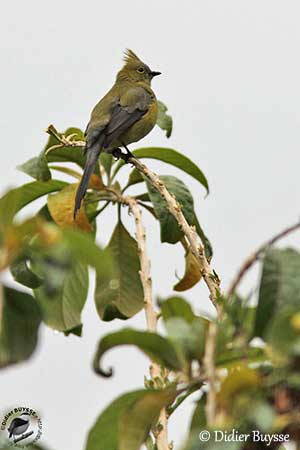
The juvenile is pale greyish-brown with darker brown uppertail-coverts. Bill, legs and feet are brownish and the eyering is whitish. On the paler underparts, the undertail-coverts are pale yellow with greyish bases.
RANGE:
The Long-tailed Silky-flycatcher is found in the higher mountains of Costa Rica and W Panama (E to Veraguas).
HABITAT:
The Long-tailed Silky-flycatcher frequents mountain forests, secondary forests and pastures bordered by wooded ravines. The species is described as “very abundant” on the high volcanoes, just below the treeline. It is present from 1,800 to 3,000 metres of elevation.
The Long-tailed Silky-flycatcher is usually observed in small flocks in montane forest, along the edges or in solitary trees in high pastures. But they can be seen alone or in pairs too.
This species tolerates many extreme climate changes in the high mountains, except the heat of the lowlands.
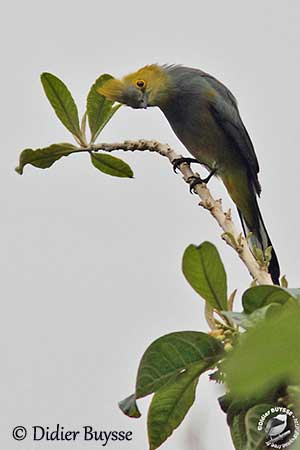
CALLS AND SONGS: SOUNDS BY XENO-CANTO
The Long-tailed Silky-flycatcher is usually noisy, but despite being a loquacious bird, this species is practically songless to the human ears.
The most common call is a sharp, dry “che chip, che chip” given both in flight or when perched. These calls are continuously repeated in alarm.
When the bird takes off or during the flight, it often utters a long-drawn “che-e-e-e-e…” described as a rattling or clicking sound, but it may sometimes become clear and metallic. Some birds on the wing give bell-like notes “re-er-re-re”.
BEHAVIOUR IN THE WILD:
The Long-tailed Silky-flycatcher feeds mainly on small fruits and berries such as mistletoe (Gaiadendron), Fuchsia and Solanum. Insects are caught in flight by hawking, following sallies from perch at treetop.
It plucks berries while perched and the food is swallowed whole. The bird feeds while perching close to a cluster or clinging to it. Both insects and berries are given to the chicks.
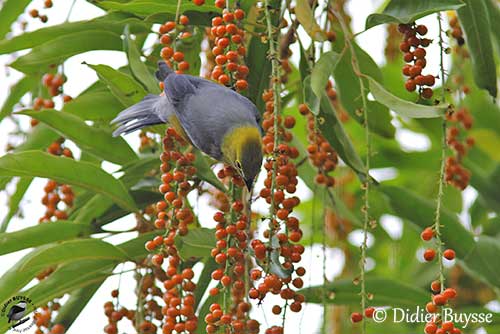
As the nesting season is approaching, the pairs separate from the flocks, although these birds are frequently seen in small groups, perched close to each other at treetops and roosting together at night.
The Long-tailed Silky-flycatcher is socially monogamous and breeds in small colonies or solitary. The pair defends a small area around the nest and forages at nearby fruiting shrubs.
The courtship displays are poorly known, but we can suggest that the erected crest and the black and white pattern of the long tail are used in displays. During this period, incubation and nest-building, the male offers berries and insects to the female. The male initiates the nest-building, but both mates take part in the later stages of the work. The nest is an open cup placed high in tree or shrub.
The Long-tailed Silky-flycatcher is resident but it may move to lower elevations after breeding.
This species flies well above the ground, often above the treetops, and travels over mountain forests or pastures with isolated trees.
During the flight, the wingbeats are irregular while the bird performs undulating flight. It usually alights on the topmost, exposed twigs of tall trees. It perches very upright and appears very elegant with the high crest and the long tail.
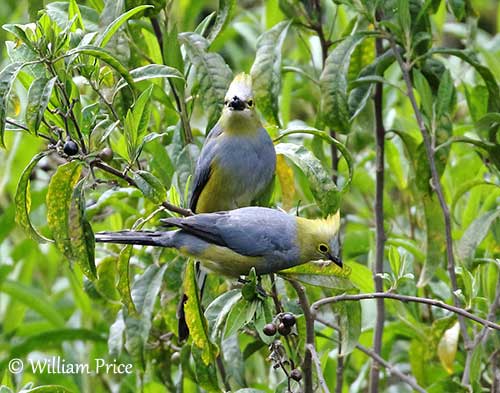
REPRODUCTION OF THIS SPECIES:
The breeding season occurs in April-June. The Long-tailed Silky-flycatcher may nest solitary or in small groups of 2-5 pairs.
The nest is bulky, an open cup made primarily with lichen of genus Usnea, a pale grey bearded lichen very similar to Usnea barbata. The birds add caterpillar silk or spider web to maintain the plant materials. The cup is not lined inside.
This nest needs a substantial support because it often becomes heavy when soaked with rain. It is usually built in a fork of tree or on top of the main stem of tall tree or shrub, and it is supported by two ascending branches. It is built among the dense foliage, but it is sometimes fully exposed.
Both mates share the nest-building, during which the male feeds the female.
The female lays two eggs and incubates during 16-17 days. She is fed by her mate during this period. It rests on a dead branch at top of a nearby tree, or on the nesting tree itself.
At hatching, the chicks have dark skin and short white down. The female broods them, but they are fed by both parents, mainly insects but also berries. They leave the nest 24-25 days after hatching, but they usually venture around the nest and may return to it for resting.
PROTECTION / THREATS / STATUS:
The Long-tailed Silky-flycatcher is a restricted-range species. It is described as “common” but the small population is suspected to be declining, due to destruction of the habitat through burning, logging and agriculture expansion.
But the species is not considered globally threatened, and the Long-tailed Silky-flycatcher is currently evaluated as Least Concern.
